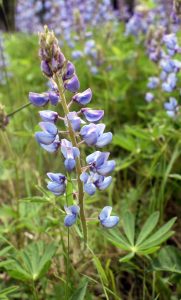Wild Lupine
 Lupinus perennis is a native perennial in the Pea family; like other members of this family its leaves are compound. In lupine’s case, however, the leaves are palmately compound (as opposed to pinnately compound) and quite as delicately lovely as the flower raceme itself which rises on a spike above the leaves to bear numerous, tightly clustered flowers. A loose analogy of ‘palmate’ is to think of a wheel with the spokes emanating out from a central point. Lupine’s leaves consist of 7 – 11 leaflets radiating outward from the central point of each leaf stalk. Flower stalks emerge alongside the leaves, sending their 8-inch long spike clusters upwards. The sight of a field of blooming lupines is wondrous indeed! A good range for bloom time is May – June. By July, all the flowers have faded and formed their typical Pea family pods — flat and somewhat hairy in lupine’s case, and filled with 2 or more seeds.
Lupinus perennis is a native perennial in the Pea family; like other members of this family its leaves are compound. In lupine’s case, however, the leaves are palmately compound (as opposed to pinnately compound) and quite as delicately lovely as the flower raceme itself which rises on a spike above the leaves to bear numerous, tightly clustered flowers. A loose analogy of ‘palmate’ is to think of a wheel with the spokes emanating out from a central point. Lupine’s leaves consist of 7 – 11 leaflets radiating outward from the central point of each leaf stalk. Flower stalks emerge alongside the leaves, sending their 8-inch long spike clusters upwards. The sight of a field of blooming lupines is wondrous indeed! A good range for bloom time is May – June. By July, all the flowers have faded and formed their typical Pea family pods — flat and somewhat hairy in lupine’s case, and filled with 2 or more seeds.
Wild lupine does not occur throughout the entire state, and is not the same species seen along the North Shore. That species is called ‘big-leaf’ or ‘large-leaved lupine’ (Lupinus polyphullus), and was introduced from western N. America. Now invasive here, big-leaved lupine crowds out several species of native wildflowers. Our native, wild version of lupine occurs in a narrow strip of counties that includes Crow Wing and Aitkin in a strip basically from Cass county southward along the eastern half of Minnesota.
Wild lupines are essential to the life cycle of the endangered Karner Blue butterfly which feeds only on wild blue lupine leaves — just one reason to preserve the habitat of these flowers. That habitat includes the sandy soils of pine barrens, oak savannas and lakeshore dune habitats where wild lupine flourishes. These area types require fire or other disturbance to maintain their sunny open patches, even if it is only along the edges of woods. Pine barrens, for example, have sandy, acidic and nutrient-poor soil, but support several specialized plant and animal species. Annually in June, I wait for wild lupines to reappear in a nearby pine barren in Crow Wing, rejoicing when they once again wave their purple petals in the wind clustered in an open area among the red pines. When they invariably do return, my heart gladdens to see them during their short blooming season. It’s well worth the wait.
